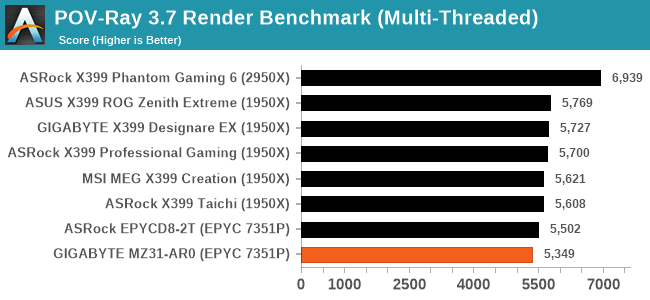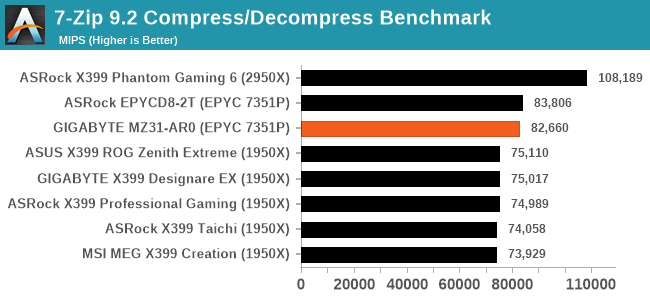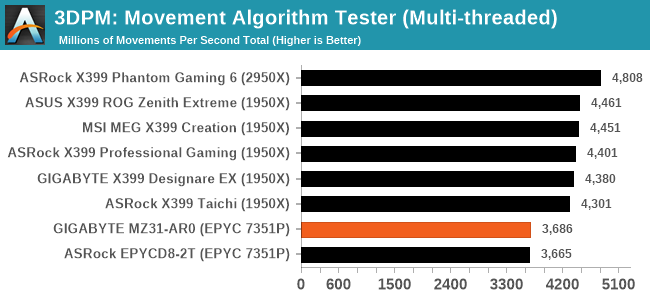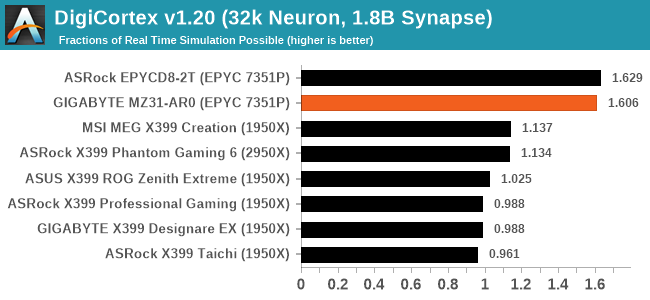The GIGABYTE MZ31-AR0 Motherboard Review: EPYC with Dual 10G
by Gavin Bonshor on March 25, 2020 1:15 PM ESTCPU Performance, Short Form
For our motherboard reviews, we use our short form testing method. These tests usually focus on if a motherboard is using MultiCore Turbo (the feature used to have maximum turbo on at all times, giving a frequency advantage), or if there are slight gains to be had from tweaking the firmware. We put the memory settings at the CPU manufacturers suggested frequency, making it very easy to see which motherboards have MCT enabled by default.
For this review we are running using Windows 10 64-bit with the 1909 update as per our Ryzen Threadripper 3960X and 3970X CPU review.
Rendering - Blender 2.7b: 3D Creation Suite - link
A high profile rendering tool, Blender is open-source allowing for massive amounts of configurability, and is used by a number of high-profile animation studios worldwide. The organization recently released a Blender benchmark package, a couple of weeks after we had narrowed our Blender test for our new suite, however their test can take over an hour. For our results, we run one of the sub-tests in that suite through the command line - a standard ‘bmw27’ scene in CPU only mode, and measure the time to complete the render.

Rendering – POV-Ray 3.7.1: Ray Tracing - link
The Persistence of Vision Ray Tracer, or POV-Ray, is a freeware package for as the name suggests, ray tracing. It is a pure renderer, rather than modeling software, but the latest beta version contains a handy benchmark for stressing all processing threads on a platform. We have been using this test in motherboard reviews to test memory stability at various CPU speeds to good effect – if it passes the test, the IMC in the CPU is stable for a given CPU speed. As a CPU test, it runs for approximately 1-2 minutes on high-end platforms.

Synthetic – 7-Zip v1805: link
Out of our compression/decompression tool tests, 7-zip is the most requested and comes with a built-in benchmark. For our test suite, we’ve pulled the latest version of the software and we run the benchmark from the command line, reporting the compression, decompression, and a combined score.
It is noted in this benchmark that the latest multi-die processors have very bi-modal performance between compression and decompression, performing well in one and badly in the other. There are also discussions around how the Windows Scheduler is implementing every thread. As we get more results, it will be interesting to see how this plays out.

Point Calculations – 3D Movement Algorithm Test: link
3DPM is a self-penned benchmark, taking basic 3D movement algorithms used in Brownian Motion simulations and testing them for speed. High floating point performance, MHz, and IPC win in the single thread version, whereas the multithread version has to handle the threads and loves more cores. For a brief explanation of the platform agnostic coding behind this benchmark, see my forum post here.

Neuron Simulation - DigiCortex v1.20: link
The newest benchmark in our suite is DigiCortex, a simulation of biologically plausible neural network circuits, and simulates activity of neurons and synapses. DigiCortex relies heavily on a mix of DRAM speed and computational throughput, indicating that systems which apply memory profiles properly should benefit and those that play fast and loose with overclocking settings might get some extra speed up. Results are taken during the steady-state period in a 32k neuron simulation and represented as a function of the ability to simulate in real time (1.000x equals real-time).











37 Comments
View All Comments
phoenix_rizzen - Saturday, March 28, 2020 - link
Stupid lack of edit button.FreeBSD on the ZFS storage servers. Linux in the iSCSI servers.
kobblestown - Saturday, March 28, 2020 - link
"and the IPMI implementation is light-years beyond what Supermicro supports (the GB IPMI is fully-web-enabled, using HTML5 KVM/console redirection, compared to the horrid Java implementation that Supermicro uses)."Errrgh, no. Supermicro has had HTML KVM since quite a while. I think all AST2400 BMCs offer it. I was quite surprised that I got it even for my old AST2400 BMC with an update. And it works as one would expect.
Deicidium369 - Sunday, April 12, 2020 - link
Yeah the GB stuff is nice, but really just playing catchup to SM.oRAirwolf - Saturday, March 28, 2020 - link
Why does nobody use the dual 10Gbe controller built into the EPYC chips? Each Zen die has 4 x 10 Gbe MAC's on board, yet the only motherboard I have ever seen to utilize them is AMD Wallaby platform development board here https://www.servethehome.com/amd-epyc-3251-benchma...My only guess is that motherboard manufacturers are worried about compatibility issues. I sure would rather save the money, energy, and heat resources and use the embedded AMD 10Gbe than another manufacturer's chipset shoehorned into the motherboard for no good reason.
mode_13h - Monday, March 30, 2020 - link
...and VGA FTMFW!!mode_13h - Monday, March 30, 2020 - link
yes, I know, KVMs...I even have a VGA KVM, myself. Although, I mostly use it as just a keyboard+mouse switch.
It's just ironic to see a board with so much modern tech, and yet it's rare to even see a VGA port on new monitors.
Qasar - Tuesday, March 31, 2020 - link
its rare ??? you sure ?? seems most of the monitors that AT mentions, have vga ports on them.... even the new one from here : https://www.anandtech.com/show/15674/tuf-goes-free... has onetravelstar - Monday, March 30, 2020 - link
I'm curious as to why we have a review of an older motherboard restricted to PCIe Gen3 slots, when the newer Z323-AR0 comes with PCIe Gen4 slots.Pyxar - Wednesday, December 23, 2020 - link
I keep running into workstation boards that are capped at 64gb of ram based on epyc or thread ripper when i'm search engine diving. Seems wrong to cap it at 64.tomholms - Tuesday, September 7, 2021 - link
Forums: these are how the discussion board is categorised. For instance, there may be one forum for general discussion, and other separate forums to discuss each of the assignments and other aspects of the unit.Threads: these are individual subjects or questions within a forum. For instance, you may have a question about an upcoming assignment that you wish to discuss with your lecturer and the other students. You would create a thread to pose this question (assuming no one has previously asked the same question).
Posts: these are individual replies within threads. If another student has an answer to the question you have posed, they would "post" inside your thread, to discuss your specific question.
https://place-4-papers.com/write-my-discussion-boa...